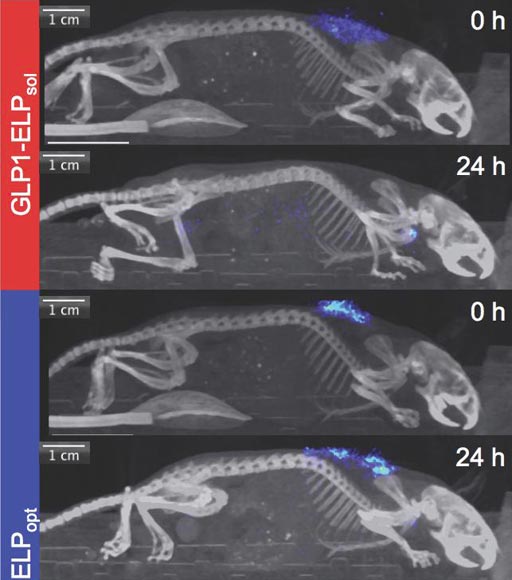Time-Release Approach for Treating Type II Diabetes
By LabMedica International staff writers
Posted on 13 Jun 2017
A novel approach to treating type II diabetes is based on a timed-release suspension of glucagon-like peptide-1 (GLP1) embedded in a thermosensitive elastin-like polypeptide complex.Posted on 13 Jun 2017
Stimulation of the GLP1 receptor (GLP1R) is a useful treatment strategy for type II diabetes. GLP1R is known to be expressed in pancreatic beta cells. Activated GLP1R stimulates the adenylyl cyclase pathway, which results in increased insulin synthesis and release of insulin. Consequently, GLP1R has been a target for developing drugs usually referred to as GLP1R agonists to treat diabetes. GLP1R is also expressed in the brain where it is involved in the control of appetite. However, the native ligand for the GLP1 receptor has a short half-life owing to enzymatic inactivation and rapid clearance.

Image: A glucose-controlling drug (blue) is shown completely dissolving after 24 hours in the body of a mouse in the top two photos. In the bottom two images, a newly optimized version of a diabetes treatment forms a \"depot\" for controlled release that persists more than 24 hours (Photo courtesy of Dr. Ashutosh Chilkoti, Duke University).
In order to increase the half-life of GLP1, investigators at Duke University (Durham, NC, USA) developed a method that embedded GLP1 in a heat-sensitive elastin-like polypeptide (ELP) in a solution that could be injected into the skin through a standard needle. Once injected, the solution reacted with body heat to form a biodegradable gel-like deposit that slowly released the drug as it dissolved.
The investigators worked with mouse and monkey diabetes models. They reported in the June 5, 2017, online edition of the journal Nature Biomedical Engineering that a subcutaneous depot formed after a single injection of GLP1 fused to a thermosensitive elastin-like polypeptide and displayed zero-order release kinetics and circulation times of up to 10 days in mice and 17 days in monkeys. The optimized pharmacokinetics led to 10 days of glycemic control in three different mouse models of diabetes, as well as the reduction of glycosylated hemoglobin levels and weight gain in obese mice treated once weekly for eight weeks.
"Although we have pursued this method in the past, a researcher in my lab systematically worked to vary the design of the delivery biopolymer at the molecular level and found a sweet spot that maximized the duration of the drug's delivery from a single injection," said senior author Dr. Ashutosh Chilkoti, professor of biomedical engineering at Duke University. "By doing so, we managed to triple the duration of this short-acting drug for type II diabetes, outperforming other competing designs."
Related Links:
Duke University













